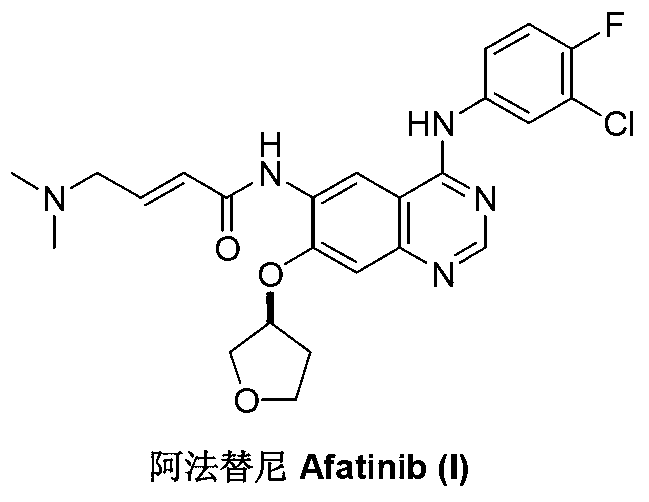Preparation method of afatinib (I)
A technology of afatinib and amino, which is applied in the field of preparation of afatinib, can solve the problems of difficult acquisition of raw materials, difficult process control, and many steps, etc., and achieve the effect of easy availability of raw materials, promotion of development, and simple process
- Summary
- Abstract
- Description
- Claims
- Application Information
AI Technical Summary
Problems solved by technology
Method used
Image
Examples
Embodiment 1
[0025] At room temperature, add diisopropyl azodicarboxylate (3mL, 15mmol) and 5mL of tetrahydrofuran into a three-neck flask, add triphenylphosphine (4.0g, 15mmol) in 25mL of tetrahydrofuran solution dropwise at room temperature, and keep the reaction at room temperature for 2 hours . Under nitrogen protection, (S)-3-hydroxytetrahydrofuran (0.3g, 3.4mmol) in tetrahydrofuran 5mL solution was added dropwise to the above reaction system, after the addition was complete, 6-amino-7-hydroxy-3, 4-Dihydroquinazolin-4-one (II) (0.53 g, 3.0 mmol), stirred at room temperature for 4 hours. A 5 mL solution of (S)-3-hydroxytetrahydrofuran (0.23 g, 2.6 mmol) in tetrahydrofuran was added dropwise, and the reaction was continued at room temperature for 2 hours, and the reaction was completed by TLC monitoring. The solvent was recovered by distillation under reduced pressure, the residue was adjusted to pH=5-6 with dilute hydrochloric acid, extracted with ethyl acetate, and the organic phase ...
Embodiment 2
[0027] Add 6-amino-7-[(S)-(tetrahydrofuran-3-yl)oxy]-3,4-dihydroquinazolin-4-one (III) (0.62g, 2.5mmol) into the three-necked flask , triethylamine (0.25g, 2.5mmol) and 20mL of dichloromethane, the temperature was raised to 40-45°C, and stirred until the system was dissolved uniformly. Drop below 10°C, slowly add 4-(N,N-dimethylamino)-2-ene-butyryl chloride (0.42g, 2.8mmol) in dichloromethane 10mL solution dropwise, continue the reaction at room temperature after the drop is complete 6 After 1 hour, TLC detected that the reaction was over. The reaction solution was washed with 10% sodium bicarbonate solution and water, and dried over anhydrous sodium sulfate. The solvent was recovered under reduced pressure, and the residue was recrystallized from ethyl acetate to obtain a white solid 6-{[4-(N,N-dimethylamino)-1-oxo-2-buten-1-yl]amino} -7-[(S)-(tetrahydrofuran-3-yl)oxy]-3,4-dihydroquinazolin-4-one (IV) 0.80 g, yield 89.4%.
Embodiment 3
[0029] Under nitrogen protection, add 6-{[4-(N,N-dimethylamino)-1-oxo-2-buten-1-yl]amino}-7-[(S)- (Tetrahydrofuran-3-yl)oxy]-3,4-quinazolin-4-one (IV) (3.58g, 10mmol), benzotriazol-1-yloxytris(dimethylamino) Phosphonium hexafluorophosphate (BOP) (6.63 g, 15 mmol) and acetonitrile 50 mL. Under stirring, 1,8-diazabicyclo[5.4.0]-undec-7-ene (DBU) (2.28 g, 15 mmol) was added dropwise, and the reaction was carried out at room temperature for 12 hours. Be warming up to 60 DEG C, continue reaction 12 hours. The solvent was distilled off under reduced pressure, dissolved in 100 mL of ethyl acetate, and washed with 20 mL of 2M sodium hydroxide. The organic phase was separated, dried and concentrated under reduced pressure. The residue was dissolved in 100 mL of tetrahydrofuran, 4-chloro-3-fluoroaniline (1.89 g, 13 mmol) and sodium hydride (0.32 g, 13 mmol) were added, the temperature was raised to 50 ° C, and the reaction was stirred for 5 hours, and the reaction was monitored by TL...
PUM
 Login to View More
Login to View More Abstract
Description
Claims
Application Information
 Login to View More
Login to View More - R&D
- Intellectual Property
- Life Sciences
- Materials
- Tech Scout
- Unparalleled Data Quality
- Higher Quality Content
- 60% Fewer Hallucinations
Browse by: Latest US Patents, China's latest patents, Technical Efficacy Thesaurus, Application Domain, Technology Topic, Popular Technical Reports.
© 2025 PatSnap. All rights reserved.Legal|Privacy policy|Modern Slavery Act Transparency Statement|Sitemap|About US| Contact US: help@patsnap.com



